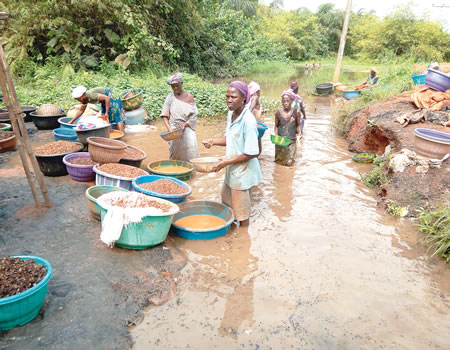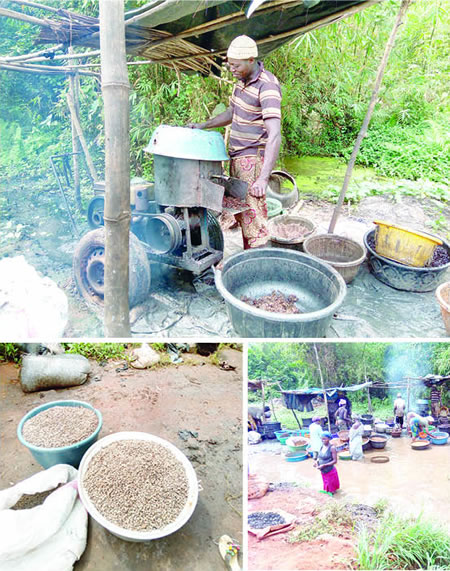The consumption of locust beans has remained very central in many homes. Added to many delicacies, the locust beans also called Iru in the South West has not lost its place on many dining tables. Communities which have prioritized the production and sale of locust beans include Gogo-Ekiti in Ekiti State, Owena-Owode in Ondo State and Agosasa in Ogun State. YINKA OLUKOYA, after a visit to Agosasa (a border town) reports the people’s undying for the production of locust beans, the grimy process of its production and the challenges therewith.
Across many parts of Nigeria’s South West are diverse human and natural resources. These resources are differently located both in quantity and diversity as one transit from community, town, city or state. It therefore becomes a usual sight to find the histories of these settlements hugely tied to their natural development especially in the area of agriculture, specific vocations or trade acumen. While some are remarked to be particularly good in certain agricultural crops others have distinguished themselves in certain trade engagements.
The above aptly captures the interesting story of Agosasa, one of the ancient towns in Ogun State. Aside sharing border proximity with Nigeria’s neighbor, Benin Republic, the town has long been regarded as one of the biggest commercial hubs in Ipokia Local Government Area where it is located in Ogun State.
Relations with neighbouring Benin Republic communities
As a result of its border placement, the town is long drawn in distance from Abeokuta, the state’s seat of administrative and political power. Through the years, Agosasa has distinguished itself both in bilateral relations with neighboring communities in Benin Republic, particularly in the area of trade. The pendulum of this trade has always oscillated between farm produce and other commercial engagements. Agosasa is populated by the Anagos, Eyos and some Eegun communities who were predominantly peasant farmers while the town’s market attracts traders from the Republic of Benin and beyond.
The ease of human movement from one end of Agosasa to these communities in the neighbouring country further cemented the trade enterprise and the urge to create other necessary platforms of interactions.
This indeed has facilitated clear-cut opportunities for others living in faraway villages and towns from Agosasa in Ogun State to use the town as a conduit to reach other Benin Republic towns for business purposes.
The town is also rich in tradition as major traditional festivals like Egungun, Ogun among others, are always well celebrated. Because of the pockets of Egun communities in the town, Sangbeto, a popular masquerade of Egun people, is also well known in the ancient town.
Sleepy, largely agrarian in outlook, Agosasa has risen as one of the biggest hubs of the production, sale and distribution of ‘Iru’ otherwise known as locust beans. For many, locust beans have remained a necessary condiment for meals and a regular sight in many markets across the country.
Because of its tasty additive place in various meals and its health benefits, it is usually common to find both buyers and sellers with an increase in demand.
When Nigerian Tribune visited Agosasa, it was indeed difficult to ignore its diverse but crude process of locust beans production. A first time caller visiting or passing through the town to Ipokia or Cotonou will travel on Odo Afa, a stream where the locust beans, is being processed need not to be told that there is a locust beans processing centre around with the aroma of the local seasoning in the air.
The Odo Afa stream was peopled with both men and women scooping water from it and crudely washing the mud from the pods. The cumbersome process and the offensive production added to the stench oozing from the stream. Those found in the water which reached the knee-length of the women involved in the cleaning could not ascertain the safety of the whole process.
Of course, as observed, that was one of the stages of the production process. At a nearby spot, grinding machines and allied equipment could be seen at the bank of the stream involved in the processing of the locust beans pods. As the stench persistently took possession of the air, observably it was an intense and yet organised production process with all hands on deck.
As this reporter inched closer, it was difficult to have an interaction with the women as they insisted on being busy
After a period of persistence, one of the women, who simply identified herself as Iyobu, told Nigerian Tribune that they usually got the pods from Cotonou in the Republic of Benin. She informed that she was born into the business of locust beans production, which according to her, is synonymous to Agosasa. She stated further that people from all over the country and beyond, come to the town to buy the locust beans as it remains probably the best in the country.
“I was born into this business and many of us here. We have been involved in the production of locust beans from time immemorial. Its production has made us popular. In fact, the name of our town, Agosasa, is synonymous with the production and distribution of locust beans. People travel from far and wide to patronise us. Because of the years of expertise that we have invested in the trade, people believe that ours is the best and it is so,” she said.
In an interaction with Nigerian Tribune, a locust beans seller, Ayoola Ayodeji, said the process could be cumbersome. According to her, “The first stage is to ensure that the pods are thoroughly washed. In most cases, these pods come with mud. That is why you will find out that through the crude process, many women take the pods to the streams near them. Others can wash the pods with a machine that is small. After that, the pods are then boiled for a whole day.
“The second stage of the process is to take the already washed pods and wash it with a second machine. This machine is bigger. After washing, you take the pods and cook properly, although you must ensure that you do not cook for too long since it is a second cooking.
“After this is done, you take down the cooked beans and allow the heat to evaporate. What it means is that you allow it to cool. This is then followed by placing a cover cloth. Just like it is done with the process of fermenting cassava. By covering, you ensure that it ferments. This is left for three days. After this, the cover cloth is removed on the third day. This follows with the coating of the locust beans with salt. It is then left to dry in the sun.”
For Mr Adesina Muhammed, the importance of locust beans cannot be overemphasized. “You can add it to many kinds of soup or stew. People even chew it just like that. It is medicinal and highly nutritional. Everyone benefits from the health benefits of locust beans. Some people even go as far as exporting this thing to their children or relations outside the country both for consumption and commercial purposes,” he said.







